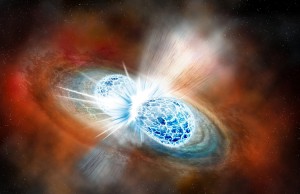Colliding Neutron Stars
Friday, October 27th, 2017October 27, 2017
On August 17, a faint chirp from instruments at the Laser Interferometer Gravitational-wave Observatory (LIGO) in the United States set off a mad scramble in observatories around the world to catch a glimpse of something never before observed: the cosmic collision of two neutron stars (an event called a kilonova). In the extraordinary events that followed, the signal initially detected by LIGO was picked up by as many as 70 Earth and space-based telescopes, providing a remarkably detailed picture of one of the most violent, cataclysmic events in the universe. The significant observation was announced by LIGO scientists on October 16.

This artist’s representation shows two neutron stars colliding, a cataclysmic event known as a kilonova. Astronomers witnessed a kilonova for the first time on Aug. 17, 2017. Credit: © Robin Dienel, Carnegie Institution for Science
LIGO is a pair of facilities built to detect gravitational waves, types of radiation created by the movement of matter through space. LIGO consists of three detectors—two near Richland, Washington, and one in Livingston, Louisiana. The LIGO detectors are designed to find gravitational waves created by such violent cosmic events as collisions between black holes, objects with gravitational forces so strong that nothing can escape them. The first gravitational waves were detected by LIGO on Sept. 14, 2015. The waves were generated by colliding black holes billions of light-years away from Earth.
The recent kilonova observation was significant for several reasons. It was the first time LIGO had detected the weaker gravitational wave generated by a collision between neutron stars, the smallest and densest types of known stars. The kilonova signal was also detected at the European Gravitational Observatory (EGO) interferometer, called Virgo, located near Pisa, Italy. With data from multiple observatories, astronomers were able to determine the starting point of the gravitational wave. As word of the signal spread, dozens of other telescopes on Earth and in space were trained on the location to detect other kinds of energy from the cosmic collision. Astronomers were able to observe the resulting fireball in visible light from telescopes. Other telescopes recorded the gamma rays, radio waves, ultraviolet rays, and X rays generated from the collision. It was the first time such a cosmic event had been seen by astronomers, witnessed in wavelengths across the electromagnetic spectrum.
The gravitational wave signal detected by LIGO came from two neutron stars orbiting each other about 130 million light-years away. Each neutron star had slightly more mass than our own sun, but all that mass was crammed into a sphere only about 20 miles (32 kilometers) in diameter. The doomed stars circled each other 30 times a second as they neared to within about 200 miles (320 kilometers) of each other. The orbit increased to about 2,000 times per second just before they collided in an impact that released a tremendous burst of energy. What happened next is uncertain. Scientists think that after the stars collided they may have formed a heavier neutron star or collapsed into a black hole.
Some telescopes were able to spot a faint flash in the night sky. That flash was generated in the fireball of the collision as radioactive heavy chemical elements were blown away at nearly one-fifth the speed of light. Scientists had long theorized that such catastrophic celestial collisions were necessary to forge heavy chemical elements, such as gold, platinum, and uranium. The spectrum of light coming from the observed collision of neutron stars helped confirm this theory. They calculated that the explosion created about 100 times the mass of Earth in gold. Scientists now believe such collisions of neutron stars are common in the universe. They believe that most heavy element atoms in the universe are formed in such kilonova events.


